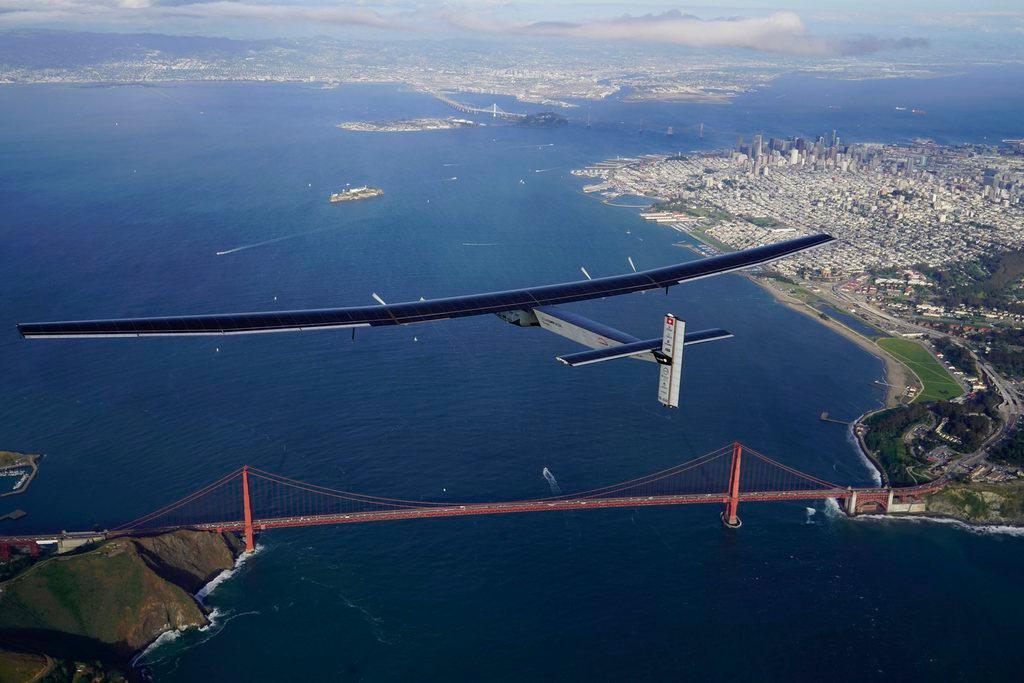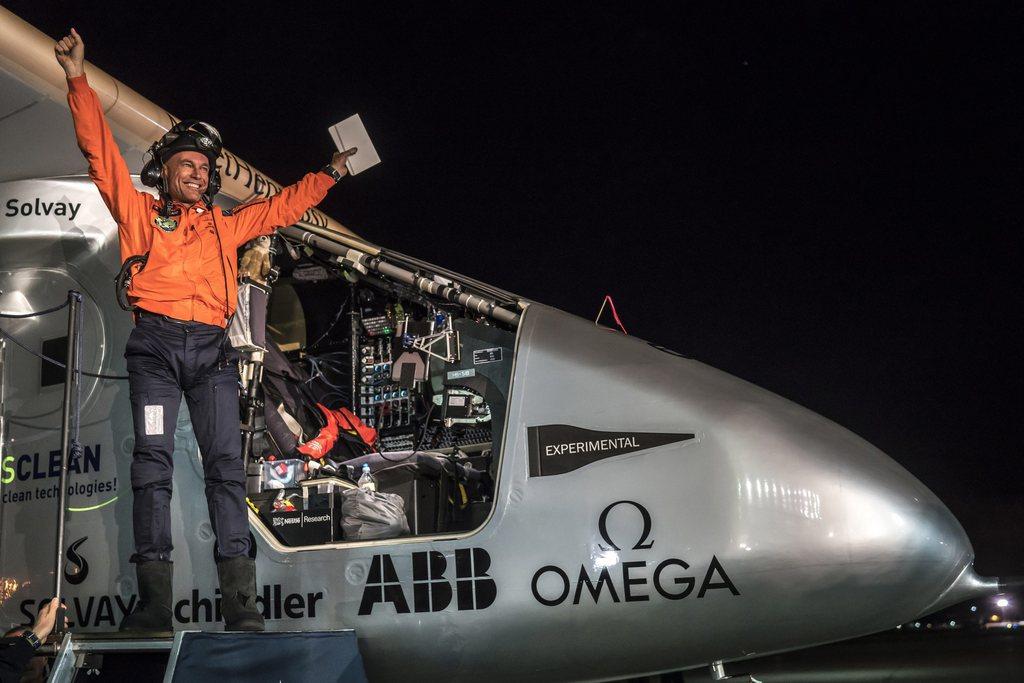
Solar-powered plane completes journey across Pacific Ocean

Solar Impulse 2, the Swiss solar-powered plane, landed in California on Saturday, completing a risky three-day flight across the Pacific Ocean as part of its journey around the world.
Swiss pilot Bertrand Piccard landed the Solar Impulse 2External link in Mountain View, in the Silicon Valley south of San Francisco, at 11:44pm local time – 8:44am Swiss time – following a 62-hour, nonstop solo flight without fuel. The plane taxied into a huge tent erected on Moffett Airfield, where Piccard was greeted by the project’s team.
Sergey Brin, co-founder of Google, one of the project’s sponsors, was also present. Google’s headquarters are at Mountain View.

“You know there was a moment in the night, I was watching the reflection of the moon on the ocean and I was thinking ‘I’m completely alone in this tiny cockpit and I feel completely confident’. And I was really thankful to life for bringing me this experience,” Piccard said at a news conference after he landed. “This is maybe one of the most fantastic experiences of life I’ve had.”
The landing came several hours after Piccard performed a fly-by over the Golden Gate Bridge as spectators watched the narrow aircraft with extra-wide wings from below.
“I crossed the bridge. I am officially in America,” he declared as he took in spectacular views of San Francisco Bay.
Look, up in the sky! @solarimpulseExternal link cruises over SF on historic flight. https://t.co/v07vvIPrgDExternal linkhttps://t.co/9QUIrTlZMpExternal link
— ABC7 News (@abc7newsBayArea) April 24, 2016External link
Piccard and fellow Swiss pilot André Borschberg have been taking turns flying the plane on an around-the-world trip since taking off from Abu Dhabi, the capital of the United Arab Emirates, in March 2015. It has made stops in Oman, India, Myanmar, China, Japan and Hawaii.
The trans-Pacific leg was the riskiest part of the plane’s global travels because of the lack of emergency landing sites.
Challenges
The aircraft faced a few bumps along the way.
The Solar Impulse 2 landed in Hawaii in July and was forced to stay in the islands after the plane’s battery system sustained heat damage on its trip from Japan. The team was delayed in Asia, as well. When first attempting to fly from Nanjing, China, to Hawaii, the crew had to divert to Japan because of unfavourable weather and a damaged wing.
A month later, when weather conditions were right, the plane departed from Nagoya in central Japan for Hawaii.
The plane’s wings, which stretch wider than those of a Boeing 747, are equipped with 17,000 solar cells that power propellers and charge batteries. The plane runs on stored energy at night.
Solar Impulse 2 will make three more stops in the United States – next stop Phoenix – before crossing the Atlantic Ocean to Europe or Northern Africa.
“The adventure continues,” Piccard said. “The story is not finished.”
The project, which began in 2002 and is estimated to cost more than $100 million (CHF98 million), is intended to highlight the importance of renewable energy and the spirit of innovation.
“I think innovation and pioneering must continue,” Piccard said. “It must continue for better quality of life, for clean technologies, for renewable energy; this is where the pioneers can really express themselves and be successful.”
Solar-powered air travel is not yet commercially practical, however, given the slow travel time, weather and weight constraints of the aircraft.
“Maybe it will be boring in 20 years when all the airplanes will be electric and people will say ‘Oh it’s routine’. But now, today, an airplane that is electric, with electric engines, that produces its own energy with the sun, it can never be boring,” Piccard said. “It’s a miracle of technology.”

In compliance with the JTI standards
More: SWI swissinfo.ch certified by the Journalism Trust Initiative
















![The four-metre-long painting "Sonntag der Bergbauern" [Sunday of the Mountain Farmers, 1923-24/26] had to be removed by a crane from the German Chancellery in Berlin for the exhibition in Bern.](https://www.swissinfo.ch/content/wp-content/uploads/sites/13/2025/12/01_Pressebild_KirchnerxKirchner.jpg?ver=cb688ed5)














You can find an overview of ongoing debates with our journalists here . Please join us!
If you want to start a conversation about a topic raised in this article or want to report factual errors, email us at english@swissinfo.ch.